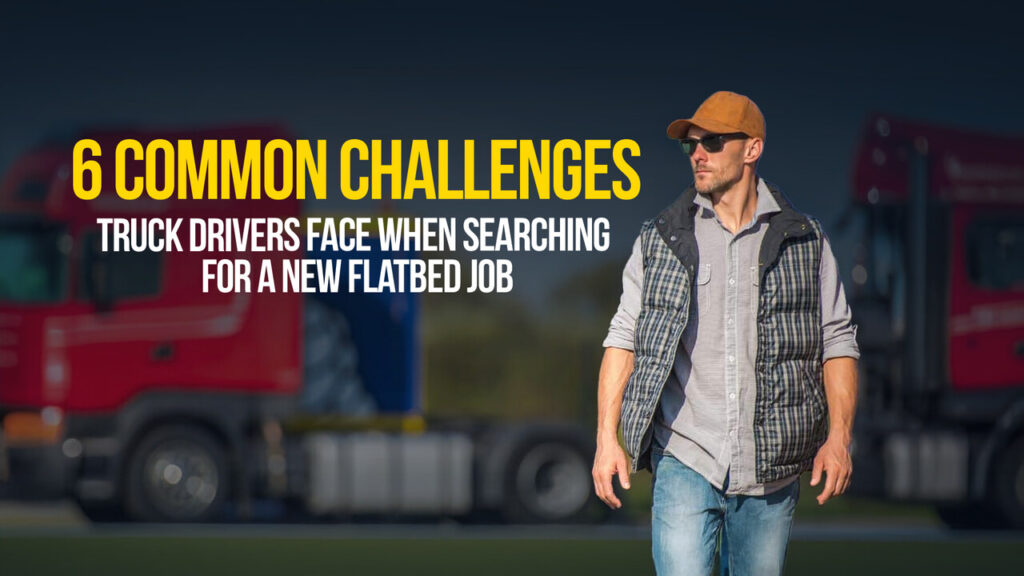
Flatbed trucking jobs offer strong pay, hands-on work, and plenty of miles—but finding the right flatbed job can be tougher than it seems. From misleading ads to mismatched expectations, CDL-A drivers often face a frustrating road when trying to switch carriers or break into flatbed freight.
At Drivers 1st, we believe in job alignment, transparency, and putting drivers first. Here’s a look at the most common obstacles flatbed drivers encounter—and how to navigate them to find a job that truly fits your lifestyle and goals.
1. Unclear Job Descriptions and Misleading Ads
Many flatbed jobs are advertised with vague or exaggerated claims—especially regarding home time, pay, and bonuses. A job might promise “weekends home” or “$100,000/year potential,” but those terms can be highly situational and rarely explained clearly upfront.
Tip: Look for job listings that clearly define:
- Pay structure (CPM, load pay, tarp pay, etc.)
- Average home time
- Equipment type and age
- Expected freight types and routes
🔗 Explore better job transparency with our True-Fit™ Lifestyle Selector
2. Lack of Flatbed Experience Requirements
Some carriers require previous flatbed experience—but don’t mention it until after you’ve applied or spoken to a recruiter. This wastes valuable time for drivers trying to switch divisions or explore new types of freight.
Solution: Ask upfront:
- Is this an entry-level flatbed job?
- Do you offer training or securement instruction?
- Is previous experience required for all routes?
If you’re a first-time flatbed driver, partner with a company that offers onboarding and support—not just equipment.
3. Mismatch Between Driver Goals and Carrier Expectations
Too often, drivers are placed in jobs that don’t match their lifestyle, resulting in burnout and high turnover. For example:
- A driver seeking regional work might be placed on OTR lanes.
- Someone with physical limitations may struggle with 100% tarp-required loads.
At Drivers 1st, our True-Fit™ system ensures drivers only see jobs that match their lifestyle preferences.
4. Long Application Processes and Delayed Responses
Applying for multiple flatbed jobs can be time-consuming. Paperwork overload, repeated phone calls, and slow recruiter responses can drag the process out for weeks—especially frustrating if you’re ready to roll.
Driver-Friendly Tip: Use platforms that streamline the CDL application and offer fast turnaround from recruiters. Drivers 1st provides transparent job matching and quick follow-ups to eliminate wait time.
5. Confusion Around Equipment and Tarping Requirements
Flatbed driving is more physical than dry van or reefer work, and not all jobs are created equal. Some involve tarping every load, others are no-touch. Some fleets run newer trailers with automatic winches—others don’t.
Checklist Before Accepting a Flatbed Job:
- Do all loads require tarping?
- Are you paid extra for securement/tarping?
- What equipment is provided (bungees, straps, tarps)?
- Are the trailers standard or extendable?
Knowing this upfront helps avoid surprises on Day 1.
6. Lack of Ongoing Support After Placement
Many drivers report that once they’re hired, communication with recruiters or placement teams drops off. This leads to feelings of being “just a number” and contributes to job dissatisfaction and turnover.
What to Look For:
Choose companies that offer post-placement support and maintain communication after you hit the road. At Drivers 1st, we check in regularly to ensure your experience matches your expectations—and your voice is heard.
Final Thoughts: Flatbed Job Hunting Doesn’t Have to Be Frustrating
Flatbed trucking jobs can be lucrative and rewarding—but only if the fit is right. The key is finding a carrier that values transparency, alignment, and support.
🚛 Ready to Find Your Flatbed Fit?
🔹 Search Flatbed Jobs Now
🔹 Talk to a Driver Advocate
We’ll help you match with reputable flatbed carriers that fit your lifestyle, goals, and values—not just your license class.
FAQ
Q: Do I need prior flatbed experience to get hired?
A: Not always. Some carriers offer on-the-job securement training. Make sure to ask before applying.
Q: Are flatbed jobs harder than other CDL-A jobs?
A: They can be more physical due to loading and tarping—but many drivers find them more rewarding and better paying.
Q: Can I switch to flatbed from reefer or dry van?
A: Yes, especially if you work with a recruiter who understands your background and goals.
For more updates and insights into the trucking world, stay tuned to Drivers1st.com!